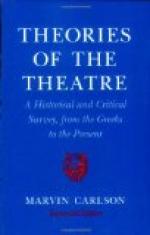Modern methods of lighting, as we have seen, have carried the actor away from the centre of the stage, so that now important business is often done far from the footlights. This tendency has led to further innovations. Actors now frequently turn their backs to the audience,—a thing unheard of before the advent of the Drama of Illusion; and frequently, also, they do their most effective work at moments when they have no lines to speak.
But the present tendency toward naturalness of representment has, to some extent, exaggerated the importance of stage-management even at the expense of acting. A successful play by Clyde Fitch usually owed its popularity, not so much to the excellence of the acting as to the careful attention of the author to the most minute details of the stage picture. Fitch could make an act out of a wedding or a funeral, a Cook’s tour or a steamer deck, a bed or an automobile. The extraordinary cleverness and accuracy of his observation of those petty details that make life a thing of shreds and patches were all that distinguished his method from that of the melodramatist who makes a scene out of a buzz-saw or a waterfall, a locomotive or a ferryboat. Oftentimes the contemporary playwright follows the method suggested by Mr. Crummles to Nicholas Nickleby, and builds his piece around “a real pump and two washing-tubs.” At a certain moment in the second act of The Girl of the Golden West the wind-storm was the real actor in the scene, and the hero and the heroine were but mutes or audience to the act.
This emphasis of stage illusion is fraught with certain dangers to the art of acting. In the modern picture-play the lines themselves are often of such minor importance that the success or failure of the piece depends little on the reading of the words. Many young actors, therefore, cannot get that rigid training in the art of reading which could be secured in the stock companies of the generation past. Poor reading is the one great weakness of contemporary acting. I can think of only one actor on the American stage to-day whose reading of both prose and verse is always faultless. I mean Mr. Otis Skinner, who secured his early training playing minor parts with actors of the “old school.” It has become possible, under present conditions, for young actresses ignorant of elocution and unskilled in the first principles of impersonation to be exploited as stars merely because of their personal charm. A beautiful young woman, whether she can act or not, may easily appear “natural” in a society play, especially written around her; and the public, lured by a pair of eyes or a head of hair, is made as blind as love to the absence of histrionic art. When the great Madame Modjeska last appeared at the Fifth Avenue Theatre, presenting some of the most wonderful plays that the world has ever seen, she played to empty houses, while the New York public was flocking to see some new slip of a girl seem “natural” on the stage and appear pretty behind the picture-frame proscenium.




